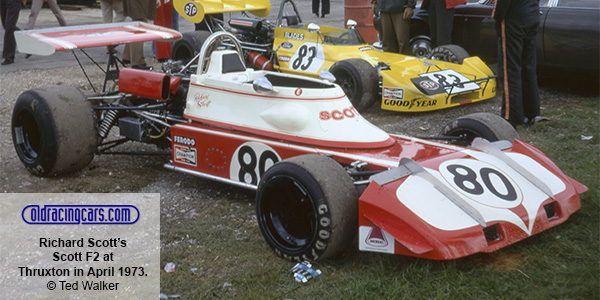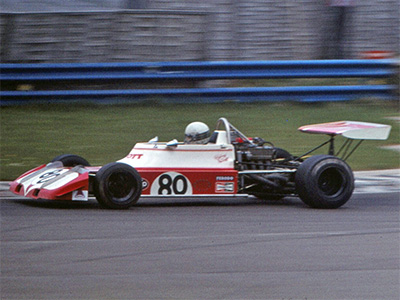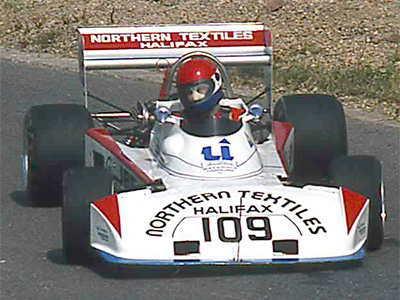Scott 1973 Formula 2 history

Richard Scott's Formula 2 Scott at Thruxton in April 1973. Copyright Ted Walker 2023. Used with permission.
Designed as a Formula 2 car by future Williams designer Patrick Head for Richard Scott, the Scott proved most effective as a Formula Atlantic car in 1974. It was later a regular winner in libre racing at Croft.
Richard Scott had been a competitive Formula 3 driver, initially with a Lotus 41 in his native Scotland in 1968 and later winning British championship rounds in 1969 and 1970. He moved up to Formula 2 in 1971 with LIRA, an ambitious but underfunded new team set up by Justin Haler and Chris Witty. When this collapsed, Scott ran the car on his own, and continued to run independently in 1972 with a new Brabham BT38, engines from Geoff Richardson Engineering and sponsorship from Uniacke Chemicals. Scott then approached an ex-Lola designer Patrick Head, looking for ideas on how to modify the Brabham for 1973. Accounts differ on whose idea it was to design and build an entirely new car, Scott saying it was Head's idea and Head saying Scott insisted on it. Head believed that the cars of 1972, such as the Brabham BT38 and March 722, were difficult to drive because the radiators had been moved to the side leaving too little weight at the front. The cars tended to understeer into corners, or, if pushed too hard, oversteer violently. With the Scott, he sited the radiators in the nose but on either side and vented through the front suspension, similar to the Brabham BT34. The car had a conventional monocoque ending behind the driver, with the engine supported by A frames bolted to the back of the monocoque. The suspension as also highly orthodox, with wishbones and outboard spring/damper units at the front, and reversed lower A frames, top transverse link and twin radius rods at the rear. To keep the weight forward, Head positioned the battery, oil tank and fuel collector pot immediately behind the driver, with nothing hung on the gearbox. He also added a 7-inch alloy adapter plate between the engine and gearbox to move the driver five inches further forward in the car.
The monocoque was fabricated from 16-gauge aluminium alloy by Grand Prix Metalcraft, and the car was assembled by Scott chief mechanic Mike Cane, assisted by John Heitman, later with Ardmore Racing. It ran on 10-inch and 14-inch wheels, with power from its 1970cc Geoff Richardson BDA engine transmitted through a Hewland FT200 gearbox. He failed to start the car's first race after an accident at the hairpin caused by the throttles being jammed wide open. Repairs left little time for testing before Hockenheim, and he was well off the pace. Engine problems at Thuxton left him well down the grid, and any chance of a good race was spoilt when he stalled on the grid for the final. He should have been well up the grid at the Nurburgring but for timekeeping problems, but had a great race in the rain, storming through to seventh place at the finish. Scott was aware that his budget would run out after Pau, but he didn't even get to race, after hitting barrier heavily during practice. After just three races, the Scott's F2 career was over.

Dick Scott in his Formula 2 Scott at Thruxton in April 1973. Copyright Steve Wilkinson 2023. Used with permission.

Geoff Lumb in the Scott at Harewood in 1982. Copyright Steve Wilkinson 2023. Used with permission.
New for Richard Scott to race in European F2 in 1973, fitted with an iron block 1970cc Geoff Richardson BDA engine. Scott crashed in practice for the opening race at Mallory Park, but raced the car in the F2 rounds at Hockenheim, Thruxton and Nürburgring in April. He then crashed again in practice at Pau, seriously damaging the car. It was rebuilt as a Formula Atlantic for 1974, and Scott proved highly competitive, finishing third in the opening round at Mallory Park, then winning his second and third Formula Atlantic races, at Brands Hatch in March and at Snetterton in April. He then crashed again at Oulton Park at the start of May when a tyre deflated and he slid off into the sleepers at Knickerbrook, severely damaging the car. The car was sold to dealer Bob Howlings, who repaired it and entered it for Scott at the British GP meeting support race, but he retired with handling problems. It was then sold to Phil Bennett (Pool-in-Wharfedale, West Yorkshire) and fitted with a Cosworth BDG engine for sprints, hillclimbs and libre in 1975 and 1976. Sold to Warren Booth (Blackburn, Lancashire) for 1977, and used in northern Formula Libre in 1977 and the first half of 1978, winning at least six races at Croft and Longridge. Booth also used it in three Aurora AFX British F1 Championship rounds in 1978. Then sold to Neville Robinson (Leeds, West Yorkshire) for libre in 1979 and 1980. It was not seen in 1981, but returned to competition in 1982 when owned by Geoff Lumb (Brighouse, West Yorkshire) and fitted with a Cosworth FVA for 1600cc class hillclimbs. He ran the car again in 1983, when it had a 1600cc BDA engine. It was not seen in 1984 or 1985, but in 1986 it was acquired by Peter Voigt (Haywards Heath, Sussex), and remained in his collection until sold to Chris Perkins (Ashbourne, Derbyshire) in 2020. Still owned by Perkins in December 2023.
Driven by: Richard Scott, Phil Bennett, Warren Booth, Neville Robinson and Geoff Lumb. First race: Hockenheim (R2), 8 Apr 1973. Total of 45 recorded races.
Acknowledgements
The car was described in Autosport 8 March 1973 pp38-39. Also useful were 'Lunch with... Patrick Head' (Motor Sport March 2021 pp50-59) and an interview on the The F1 Grand Prix Drivers Club website. Thanks to Ted Walker and Steve Wilkinson for their photographs.
If you can add to our understanding of this car, please email Allen at allen@oldracingcars.com.
These histories were last updated on .